Tags
With the Royal Barge Procession scheduled to sail on the Chao Phraya tomorrow (November 9th), it seemed like an appropriate time to post an article about the most beautiful, well-known, and highest ranked barge, The Royal Barge Suphannahong. Featuring the graceful swan-like head of the Hongse, it is a popular symbol of Thai cultural heritage and a masterpiece of boat building. And it is the only barge in the word that is literally fit for a king.
The Suphannahong, or Suphannahongse Royal Barge is the King’s personal barge and bears a covered throne, obviously in any Royal Barge Procession it is the most important boat. The elaborate golden hongse, a mythical bird in both the Hindu and Buddhist religions that serves as the steed of Brahma is mounted at the barge’s prow, making the boat instantly identifiable. And it is the only barge whose singalman directs the oarsmen using castanets (all other barges’ tempo is set by tamping wooden poles).
Because of the King’s ill-health, he will not be attending the Royal Barge Procession but instead will be represented by his son, Royal Highness Crown Prince Maha Vajiralongkorn, who will be on board the Suphannahong. While many pundits question who will succeed the King when he dies, that the Crown Prince is being given the place of honor on the Suphannahong speaks volumes.
King Rama I had the original barge built soon after his accession to the throne in 1782. The boat was in constant use as the Principal Royal Barge until she became too old to be repaired. King Rama VI then commanded the building of her successor, the present Suphannahong which was launched on November 13, 1911. Most of the barges were damaged or destroyed during WWII and rebuilt or reconditioned by order of HM King Bhumibol.
Suphannahong is made out of a single trunk of teakwood and measures just over 150 feet in length making her the world’s largest dug-out vessel. The most majestic of all Royal Barges, the story is told that the master craftsman who built the Suphannahong threw away all his tools after her completion and vowed never to work again. The barge’s masthead holds a crystalline ball and tassel in her mouth. Her feathers, made of gilded and mirrored ornaments, flow in the wind along the length of her body, ending at her flame-like tail. In motion on the water the golden hamsa is presented in full flight powered by the oarsmen’s rhythmic motion; her paddles flashing in the sunlight suggests the graceful movement of her wings.
The royal barges of Thailand are the last of their kind in the world. Each is carved from huge pieces of teak with prows carved into mythical creatures, gilded in gold and intricately decorated with tiny shimmering pieces of glass.
The procession scheduled for tomorrow marks the visit of members of the royal family to Wat Arun, a royal temple, to present offerings of saffron kathin robes, food and other necessities, to the monks to mark Awk Phansa, the end of the three-month Buddhist rains’ retreat.
Officially known as the Praratcha Phithi Phra Yuha Yatra Cholamak (Royal Waterway Procession), the waterborne procession comprises a flotilla of 52 traditional-style barges, including the four major royal barges. This procession, the Major Battle Formation (Petch Phuang Formation) dating from the time of King Narai, has the barges arranged in five columns, with the Royal Barges in the center and two rows of war barges on each side. The mile long flotilla which begins at the Wasukri Royal Port, stretches along the Chao Phraya River, and starts with the trumpeting of conch shells and the beating of chana and mahorathuk drums that begin the royal anthem.
Related Posts You Might Enjoy:

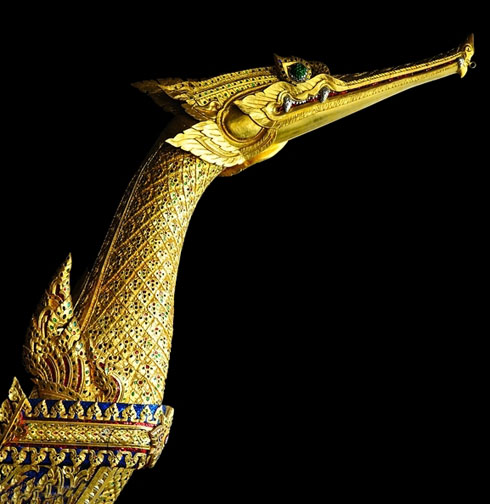
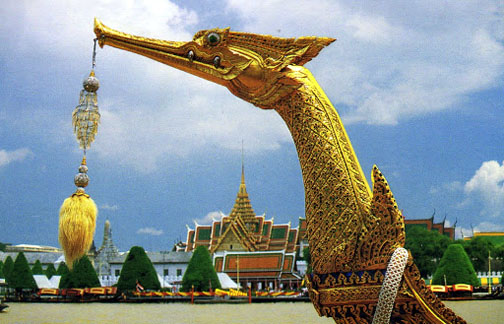
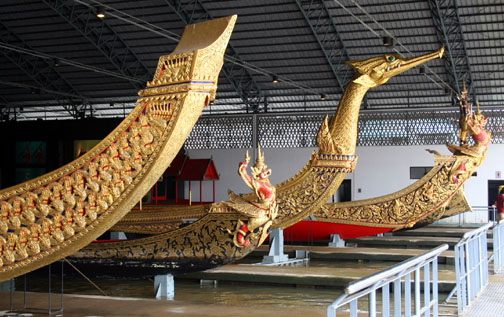
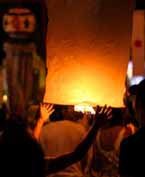
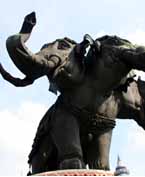
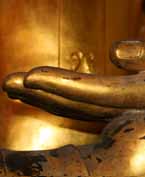
This is in Thailand? Wow, I had no idea. What city? 😉
Actually, the royal barges fascinate me. I once saw them practice & I’ve been to the museum twice by boat & once by motorcycle taxi through some narrow sidewalks. I’ve bought all the Thai stamps and currency depicting the royal barges.
Oh Mitch [shakes head is sorrow],
You really need to avail yourself of the Jabba Day Trips & Tours Company’s services. They don’t hunt out too many hidden gems, but every tour is catered by Monte.
Last year when they cancelled the procession while I was in town I tried to act as though I understood what with all the loss to property and lives caused by the floods, but ya know, they’re boats! They would have survived. I hate when the universe conspires to put a dampener on my holiday.
At this point I think there should be no question who will succeed the King. It’s been pretty obvious over the last several years.
I think so too, but there are the hopefuls who think HRM will name the dyke as his successor because one of the constitutions allows him to pick rather than follow tradition.
Trully a great thing to watch this event. If you are in Bkk no excuse.
As for the future King well, common knowledge HRH the Crown Prince is somewhat not favoured by the people. End of the Chakri dynasty? Who knows. I hope not.
I think that’s the bigger concern. Without the support the current King has Thailand’s monarchy may become but a shadow of its former self.